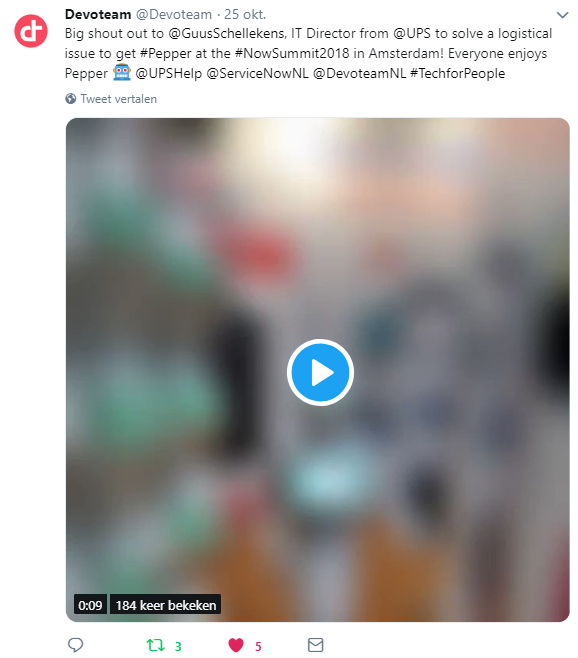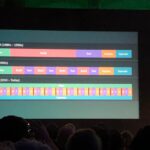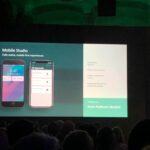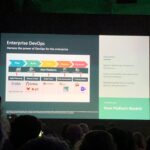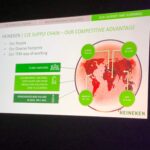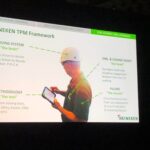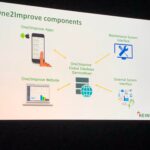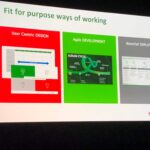Listen, learn and act
Listen, learn and act. This is the mantra of ServiceNow, pointing out the way in which they intend to learn from customers every day and base improvements upon this, according to the senior vice president of EMEA, Mr. Philip van der Wilt. Read on to discover the most important takeaways of the day.
My day started well when I heard that our robot Pepper had arrived in the morning, despite the latest news the night before. A UK based transport driver delivered Pepper in the early morning from the heart of the UK. All thanks to great customer service from UPS and UPS IT Director Guus Schellekens who went to great lengths to get Pepper to Amsterdam in time.
The Devoteam booth was decorated well, the team was prepared for visitors and the catering was brilliant. One interesting demo I saw was a locker that stored power banks and could be opened by providing an order via a tablet. After authorization / authentication, the door of the locker was opened automatically. This is making human provisioning redundant. For the customer this provides the freedom of getting the powerbank, laptop or other ‘consumables’ when necessary. The provisioning partner only needs to take care of having enough storage in the locker.
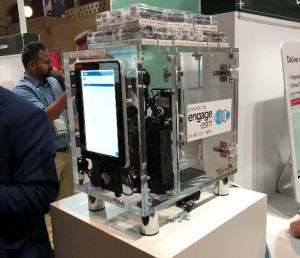
Project method development
What I learned from the introduction keynote was how the release cycle of the software had been changed from the Waterfall method (1980’s – 1990’s) – consecutively plan, build, test, deploy and operate via the Scrum method (2000s) – start with plan, then iteratively build and test, and then ending with deploy and operate.
After that came the DevOps method (2010 – today) – iteratively build, test and deploy with continuous planning and operating. The interesting part is that the upcoming Madrid release supports DevOps on the Now Platform (Enterprise DevOps). Another nice feature which will be in the Madrid release is the Mobile Studio, making it possible to apply changes within a low code / no code environment.
Case Quby domotics with CSM
Then after the break I attended the session of Quby, a company that has delivered TOON, a well-known product in the Netherlands, which is a smart thermometer in your home with which you can get insight into your energy usage. Toon focuses on anticipating on your habits (coming home, leaving) via machine learning / pattern recognition and ability to manage climate control, remotely as well via an app.
On the Now Summit Quby presented another story, in which they had collaborated with insurance company Interpolis to develop Thuiswacht, combining Home security and Home insurance in one solution. The device contains a camera and can observe people entering the room, notify the owner via an app, and the option to notify a professional security service or your own network.
In order to deliver the device and service, Quby used the CSM module from ServiceNow. They were able to deliver the requested functionality (scope) on time and under budget. The Now platform provides the option to quickly deliver and scale the solution, while making use of self-service for customers on the CSM portal.

Quby’s presentation at the Now Summit 2018 in Amsterdam
Case: Heineken’s Supply Chain Management with CSM
Finishing lunch, I heard about Heineken’s interesting use of ServiceNow in their Supply Chain Management (SCM). They focus on operational excellence and have a nice framework called TPM to connect strategy with execution. Using an app, called One2Improve, Heineken enables different parties to either share knowledge when they experience an issue or have a best practice for the global community. Actually, this is a complete platform in which the app is for the users, then there is the One2Improve website, a maintenance interface for configuration and an external system interface to enable devices to be connected to the platform. All of these interfaces are connected with the ServiceNow One2Improve Global Database.
Another interesting approach they took is the development of this platform, where the starting point was to define the necessary requirements for the end user. So they created a user centric design, developed it agile, and used the waterfall deployment to deliver in batches. They called this approach the ‘Fit for purpose’ way of working. The top learnings they showed were: don’t get ready, get started! The other takeaways being the fit for purpose way of working, and that you need to select a partner that firmly believes in your solution.
Case: HR at Philips
Philips has already been through a number of HR improvements. At the start of 2018 they were ready for the next transformation. Their HR service delivery model was built around the HR portal and HR case management system. This solution didn’t meet their needs in terms of user experience and functionality. Changes could not be made quickly and flexibility was lacking: a very slow and labor intensive setup. It required high manual work to improve performance based on analytics and usage data.
ServiceNow’s business objective goals for Philips’ HR was: to have ‘How to’ process information, reduce tier 1 questions, no duplication of content, continuous improvement of the SDM, agility for HR to continuously tune the tooling to business needs and more consistent and efficient service through a standardized workflow. It took 6 months to complete the project. Some of the results:
- an increase to 98,5% first time right
- they restored their NPS above the target of 60%
- local content quality was rated 4,01 on a 5 point scale
After that, the presenter showed us the HR portal (created in ServiceNow): it looked simple and very nice! A clear landing page, easy browsing through categories with clear icons. The lessons learned for Philips were: select the right people and free them up for the challenge. Select the right integration partner, train your team in agile upfront, for a global virtual project, recognize the importance of face2face interaction and be bold, stick to your key design decisions.
Top takeaways: Philips is now making data driven decisions, with their new solution they have that data. Include your users or use design thinking to develop your solution and stay with the standard functionalities as much as possible, there is more than enough flexibility.

ServiceNow’s promising Madrid family
The last session I attended was the closing session. The number one highlight for me was the Mobile Studio, which will be available in the Madrid release. Also the Flow designer for the Virtual Agent, making you able to create your flows without coding, but just drag and drop instead. Another highlight was the demonstration of the service intelligence, providing self-service via a chatbot experience with dialogue support, proposing a solution (answer) but then also the ability to create a case automatically.
It was an interesting day, listened and learned from the cases, spoke with interesting people and closed the day with great colleagues in down town Amsterdam enjoying beers and good food!
Video impression: Now Summit 2018 Amsterdam
Improve your Business Process Excellence with Devoteam
We at Devoteam strongly believe in guiding companies through their digital battles, and helping them win. Nowadays organizations have to go through a continuous evolution process. During these, as we call them, Digital Transformation processes changing business and IT processes is of key importance. Keeping traditional business processes alive while the world has moved on to a digital era is somethng organizations simply can not afford to do anymore.
We optimize an automate business processes from two perspectives:
- Changing business processes to align with technological changes
- Changing IT processes to align with strong business processes
